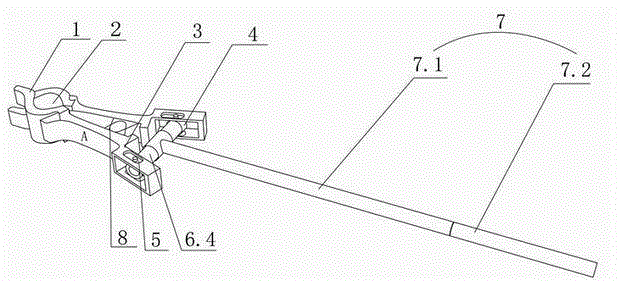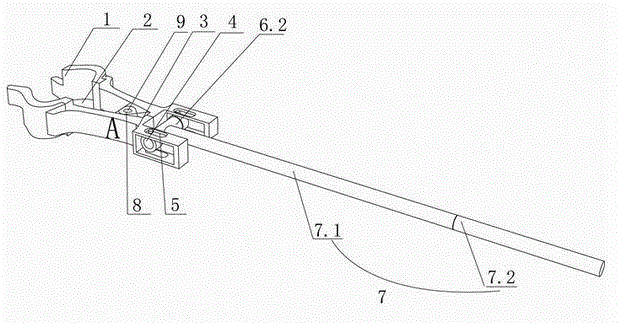Short-circuit grounding device
A technology of grounding device and wire end clamp, which is applied in the direction of circuit, connection, conductive connection, etc., can solve the problems of inconvenient operation, poor safety, easy to fall off, etc., and achieve the effect of simple operation, convenient torque design and high safety performance
- Summary
- Abstract
- Description
- Claims
- Application Information
AI Technical Summary
Problems solved by technology
Method used
Image
Examples
Embodiment 1
[0036] Such as Figure 1-4As shown, the short-circuit grounding device of the present invention includes a wire end clamp A and a handle 7. The wire end clamp A includes a pair of splints 1 connected by a support piece 8 to a steering shaft and the upper part is provided with an arc-shaped engagement 2. The support piece 8 is a rotating shaft 9 A spring is wound on the top, and the two ends of the spring are against the inner side walls of the two splints 1; the tail A of the wire end clamp is provided with a pairing module 3, and a movable nut 4 is arranged in the pairing module 3, and the movable nut 4 passes through the screw and the setting Connected to the movable piece 5 on the module 3, the movable nut 4 can rotate laterally along the screw rod, and the movable piece 5 can slide on the paired module 3; Side cylinder 6.4, side cylinder 6.4 is hollow, it can expand and contract in the cover cylinder 6.2 through the limit slider 6.6, and will not rotate, the other end of t...
Embodiment 2
[0039] The difference from Embodiment 1 is that the inner side wall of the first splint 1 is also provided with a depressing tongue 10, which is arranged between the rotating shaft 9 and the arc-shaped bite 2, and the other splint 1 is correspondingly provided with a depressing tongue 10. Tongue hole. The function of the depressing tongue 10 is that when the wire end clamp A is in the open state, the depressing tongue 10 is used to resist the wire end clamp A, so as to avoid the force of the spring to make the telescopic rod 6.1 move back. When it is necessary to loosen the splint 1 for clamping, the pressing tongue 10 contacts the wire, and the wire end clamp A can be released. The remaining technical principles are the same as in Embodiment 1.
Embodiment 3
[0041] The difference from Embodiment 1 is that the telescopic rod 6.1 and the rotating rod 6.3 are threaded as a whole, and the rest of the operation methods are the same as in Embodiment 1.
PUM
 Login to View More
Login to View More Abstract
Description
Claims
Application Information
 Login to View More
Login to View More - R&D
- Intellectual Property
- Life Sciences
- Materials
- Tech Scout
- Unparalleled Data Quality
- Higher Quality Content
- 60% Fewer Hallucinations
Browse by: Latest US Patents, China's latest patents, Technical Efficacy Thesaurus, Application Domain, Technology Topic, Popular Technical Reports.
© 2025 PatSnap. All rights reserved.Legal|Privacy policy|Modern Slavery Act Transparency Statement|Sitemap|About US| Contact US: help@patsnap.com



